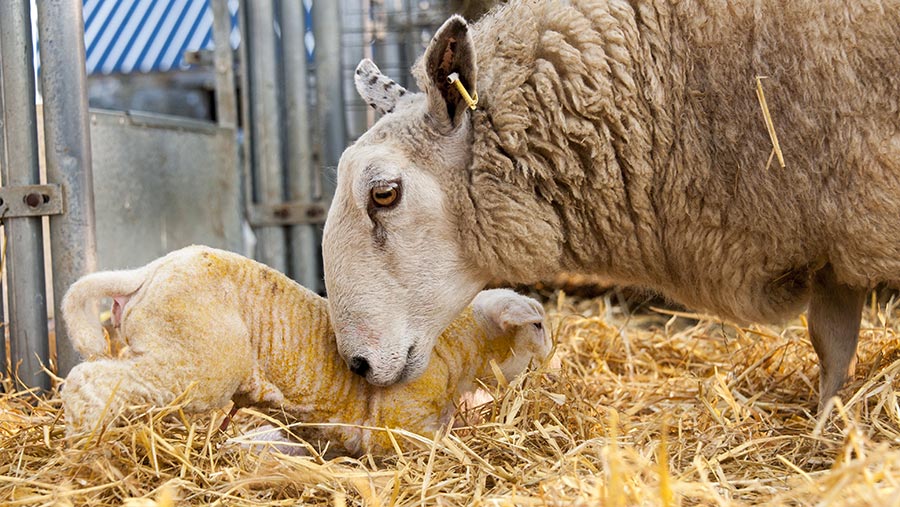Vets urge tightening of antibiotics use in neonatal lambs
 © FLPA/REX/Shutterstock
© FLPA/REX/Shutterstock Oral antibiotics use is the “principle concern” of sheep sector leaders, who have this week called on vets to reduce, refine and replace antibiotics in the sheep industry.
A cross-sector letter from sheep vets, the NFU and National Sheep Association (NSA) said the blanket use of antibiotics in neonatal lambs is “not appropriate”, issuing two leading vet publications with the latest antibiotics guidance.
See also: Campaigners ramp up pressure on farm antibiotics use
This follows Responsible Use of Medicines in Agriculture (Ruma) targets set last year, which included cutting sales of prophylactic antibiotics for neonatal lambs by 10% between 2017 and 2021.
Ruma antibiotics use targets
- The sheep sector has suggested it should concentrate on the way antibiotics are used, rather than the actual quantities used due to relatively low antibiotics use
- Increase abortion and foot-rot vaccine sales by 5% to 2,000
- Cut antibiotics use by 10% between 2016 and 2020
- Cut critically important antibiotics use by 50% by 2020
- Develop an antimicrobial use calculator by end of 2018
The letter, sent to the Veterinary Record and Veterinary Times on Friday (23 February), drew attention to the Sheep Veterinary Society’s Responsible Use of Antimicrobials Good Practice Guidelines, which is available online.
Unauthorised drugs
The letter voiced concern at anecdotal reports of unauthorised and unlicensed use of antibiotics in sheep flocks, such as tablets.
“The use of unauthorised products must be fully justified and have clearly auditable clinical evidence,” the letter stated.
“We would particularly ask colleagues to refrain from using the high-priority critically important antibiotics in sheep.”
The NSA stressed the reports were anecdotal and not widespread.
How are antibiotics used?
A total of 10.5m doses of oral antibiotics for lambs were sold to farms for the UK’s 33.3 million-head sheep industry in 2015.
Lameness and abortion control were the two other management areas that used high volumes of antibiotics, the letter said.
Starting to use less antibiotics
Vet and sheep breeder Neil Laing of Clyde Vet Group, based around Lanark and the central belt, says blanket oral antibiotics were a “belt and braces” approach in the past, but it is time for flocks to look to cut blanket oral dosing.
And while antibiotics treatments are only small (1ml), he says farmers should start to look at using antibiotics more responsibly.
“It’s about collective responsibility,” he says. “There are lots of management methods we can use to make sure lambs are fit and healthy. Minimising what we use is the right approach, but we aren’t telling farmers not to use it – just to get people asking where they can start cutting it out without seeing impacts, which I think is healthy singles and twins of ewes because a lot of lambs don’t need an antibiotics dose.”
Ways to start cutting back
- Inspect healthy singles – they may not need the dose
- Twins from ewes may not need it
- You can reduce treatment by more than 50% by focusing on triplets and the twins of first lambers
- Has it sucked and had a good feed of colostrum? Then it may not need antibiotics for watery mouth
- Pathogens can build up in the lambing shed throughout the lambing period, so try without antibiotics in early lambing
- Keep pens dry and ewes in good condition to reduce the need for antibiotics later in lambing
Tips from veterinary surgeon Neil Laing, Clyde Vet Group
Ensuring quality colostrum intake and hygiene can help cut antibiotics use
Laura Higham is veterinary programme manager at FAI farms, a research and consultancy organisation based near Oxford. FAI farm devised the five-point plan for lameness in sheep.
“The blanket use of antibiotics in indoor lambs is quite common for the prevention of issues such as watery mouth, colisepticaemia and joint ill,” says Ms Higham. “However, antibiotic use can be reduced by implementing other means of disease prevention with veterinary advice, through management and husbandry measures such as ensuring sufficient, quality colostrum intake, and hygiene in the lambing shed and during assisted lambings.
“The timely release of the Sheep Veterinary Society’s Responsible Use of Antimicrobials Good Practice Guidelines will assist vets and their farming clients in meeting the Ruma task force targets.
“This sound and practical advice contributes towards industry efforts to ‘reduce, replace and refine’ antibiotics use in animal agriculture, and includes other important interventions such as FAI’s five-point plan for tackling sheep lameness and use of inactivated vaccines in the face of enzootic abortion storms, instead of whole-flock antibiotics.”
